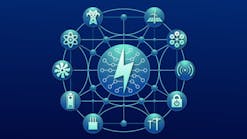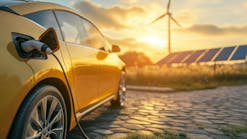V2G’s Next Frontier: Modeling the Success of Electric Bus Batteries with Tractors
The deployment of electric school buses is accelerating, much like the rapid ascent of electric cars. Just this past February, Montgomery County Maryland Public Schools, just outside Washington, D.C., awarded a contract to supply the district with what will be the country’s largest electric school bus fleet.
According to Greentech Media, 326 new electric buses will be delivered over the next four years. The winner of this contract, Highland Electric Transportation, is backed by venture capital and innovative thinking.
Montgomery County’s fleet will require five bus depots equipped with charging stations, each of which will grow to 5 MW a piece. A wrinkle in the deal is that Maryland has not yet approved rate structures allowing utilities to rate-base investments for “make-ready infrastructure”— the infrastructure needed to support electric vehicle (EV) charging and transportation electrification. So, Highland will have to bear those costs.
While the school district has a budget for the buses, the incremental costs of the electrification and charging of the buses will have to be recouped from revenue derived through vehicle-to-grid (V2G) technology — an innovation that enables energy to be pushed back to the power grid from the battery of an EV. That revenue comes from selling energy, capacity and other electrical products to the wholesale market.
The news of Montgomery County’s fleet of school buses is an example of similar initiatives unfolding in other school districts across the country. But school buses don’t hold a monopoly on this innovation. Other types of vehicles with similar operating patterns — namely, industrial and agricultural tractors — can also capitalize on it. As Green Car Reports noted, substituting electric vehicles for fossil fuel vehicles in industrial and agricultural use helps reduce emissions from tailpipes.
What’s particularly attractive about V2G is it uses energy efficiently. Electric vehicles may also reduce operating costs. Business reports show us daily that investors have concern about environmental impacts, and that concern aligns squarely with V2G in industrial and agricultural uses.”
Like school buses, the tractors have a bulk that allows for larger battery sizes and a usage pattern that includes periods of time when they are not driven. They can thus operate as a battery, providing energy, capacity and ancillary services to the wholesale energy market. Tractors run only part of a day and then sit idle, which is a key to V2G. These facts have been known for a while.
A report commissioned in 2008 by California Air Resources Board showed how prevalent gasoline and diesel are as a fuel in agricultural and industrial equipment, and laid bare how few hours such equipment is used. While there are 8,760 hours in a year, the report found diesel tractors are used just 370-420 hours annually.
It’s easy to see that agricultural and industrial equipment will work as well — or even better — than school buses for V2G. And, of course, returning to a central depot where charging on an economic scale can be done, and where bidirectional inverters can allow V2G services, all work perfectly fine with tractors. Plus, you can add to this the benefits of lowering the costs for maintenance and long-term usage.
What’s stopping a massive, speedy deployment of electrified tractors capable of V2G services? For starters, public policy and incentives may play a role. States and their utility commissions need to consider legislation and promulgate regulations giving the right incentives to distribution utilities to build the infrastructure for hosting depots that draw 5 MW+ to charge fleets.
As with incentives offered to speed deployment of electric and hybrid cars (for example, access to high-occupancy vehicle lanes) incentives could be considered to hasten vehicle electrification in industrial and agricultural settings. Such incentives could take shape as credits for carbon offsets, tax incentives or grants.
The Federal Energy Regulatory Commission (FERC) should also get the incentives right for spurring V2G development. FERC did take action last year to expand ways for EVs to take advantage of revenue opportunities from V2G. Order 2222, for example, is designed to enable distributed energy resource aggregators to compete in all organized wholesale electric markets. Its goal is to empower new technologies to come online and participate on a level playing field, enhance competition and drive down costs for consumers.
Also crucial is the need to develop new transmission lines. This will allow for a more diverse, mesh network of transmission and less reliance on point-to-point pathways that are susceptible to weather or other disruptions. Studies show that the goal of decarbonized electric generation depends critically on this expansion. Another step would be Congress enacting statutory authorization to overcome the shortcomings of the 2005 Energy Policy Act for developing transmission.
Beyond expanding the grid, the distribution system should also be upgraded to fully enable V2G technology. Bidirectional flow of energy to and from the batteries in these industrial and agricultural vehicles will be essential. This could mean upgrading metering and telemetry systems. This, in turn would require determining how that process will be funded and how quickly those upgrades would be made.
Regulatory changes in the utility arena will also be vital to provide the framework for deploying depot-scale charging stations. There are practical reasons why individual states vary in determining who owns the charge points and what part of that goes into the rate-base. Key concerns are population density and fairness in allocating cost burdens. But the overall direction should be clearly illuminated by state utility commissions so that the distribution system gets beefed up enough to handle the increased load.
On the revenue side, there’s the question of what rates should be paid for sales of V2G services. Would they be cost- or market-based? We’ve already seen concerns about net metering programs. Will V2G require reassessment of those programs so that costs and benefits are borne fairly by all utility customers?
Another critical factor is rate design—the price charged for the kilowatts and megawatts used to electrify vehicles. This will require answering such questions as whether it should be equal to the rate charged for commercial and industrial users for lighting and space heating. Or, perhaps, the rate for charging vehicles would include some portion that makes up for the loss of highway funding included in the price per gallon of gasoline.
Other issues that will need to be sorted out include the point of charging, and the role of competitive suppliers will be versus utilities with franchised service territories. Will competitive suppliers be needed to realize the most technological innovation? What are the risks of stranded costs considering the heavy technology element here? Frequently replacing charging equipment as often as we get new cell phones is impractical, to say the least. So, making technology choices that allow for upgrading easily and cost-effectively will be essential.
In sum, as a National Renewable Energy Laboratory Study from 2017 made clear, the requirements, costs, and benefits of V2G must be balanced among the three primary stakeholders: vehicle manufacturers, vehicle owners, and grid operators. Vehicles must be equipped with the capability to allow for two-way flows of electricity between the vehicle and the grid. Manufacturers must be able to price V2G capability at a level that customers will be willing to pay.
Owners must be adequately compensated for allowing the grid operator to use the vehicle to provide grid services. They must also be assured that the vehicle will be available for personal use when needed. The grid operator must derive enough benefit from the availability of vehicles to compensate for the additional cost of monitoring and controlling the vehicle-grid interactions, paying owners, and administering the system.
Though these tasks may seem onerous, there is an urgency for considering V2G. During the first 18 years of this century, global energy use rose by 50%, with 85-90% of that increase coming from fossil fuels, according to a new book, “Grand Transitions: How the Modern World was Made,” by Vaclav Smil.
As authors of this article, we feel this on a personal level. We are father and son, separated by 40 years, yet mutual fans together of all things outdoors, from mountain slopes to our sandy shores—and everything in between. To us, this situation is worrying. For current and future generations, the opportunity to act now is imperative because energy transitions move slowly, with occasional spurts of evolutionary change. Development of the U.S. interstate highway system or the interstate transmission grid, for instance, each was decades in the making, and continues today.
It is notable that solar and wind generation keeps getting cheaper, and total output is climbing at an accelerating pace. But even with this promise, as the recent devastating winter storm in Texas lays bare, more resources are needed. We cannot rely solely on intermittent resources that, with the whims of weather, will be unable to produce electricity 24 hours a day. Indeed, following the aftermath of that storm, an NBC News report observed, “Electric grid regulators said the U.S. will have to develop vast supplies of power storage—such as gigantic batteries—that rely on emerging technologies that have only recently started becoming economical and feasible on a large scale.” It is for this reason that V2G technology could help mitigate the impacts of such storms.
Developing such technologies will move us forward to address shortcomings as the U.S. approaches 2035, the year the Biden administration aims to decarbonize electric generation, and 2050, the year when the administration wants transportation to be decarbonized. There is certainly a lot of work to be done for us to realize those goals, and the benefits of V2G technology applied for industrial and agricultural tractors offers a real boost toward to them.
We are excited by the opportunities to help make this happen. Both young and old alike see the challenges and the urgency. We welcome the chance to help our communities make the energy regulatory and public policy changes needed to realize this full potential. Tractor fleets are the next frontier for electrification and V2G.


